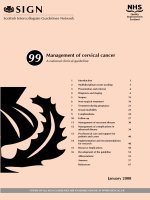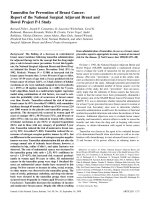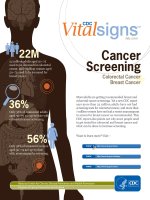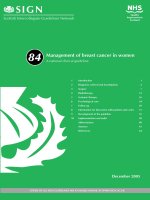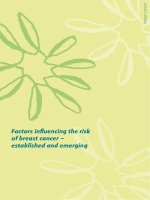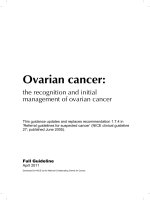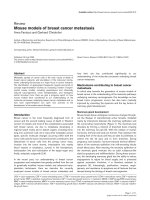Guidelines for management of breast cancer ppt
Bạn đang xem bản rút gọn của tài liệu. Xem và tải ngay bản đầy đủ của tài liệu tại đây (810.03 KB, 57 trang )
EMRO Technical Publications Series 31
Guidelines for management
of breast cancer
WHO Library Cataloguing in Publication Data
Guidelines for management of breast cancer/by WHO Regional Office for the Eastern Mediterranean
p. (EMRO Technical Publications Series ; 31)
1. Breast neoplasms – Diagnosis
2. Breast neoplasms – Therapy
3. Breast – Cancer
4. Breast – Cancer – Guidelines
I. Title II. WHO Regional Office for the Eastern Mediterranean
III. Series
ISBN : 978-92-9021-405-2 (NLM Classification: WP 870)
ISSN : 1020-0428
© World Health Organization 2006
All rights reserved.
The designations employed and the presentation of the material in this publication do not imply the expression
of any opinion whatsoever on the part of the World Health Organization concerning the legal status of any
country, territory, city or area or of its authorities, or concerning the delimitation of its frontiers or boundaries.
Dotted lines on maps represent approximate border lines for which there may not yet be full agreement.
The mention of specific companies or of certain manufacturers’ products does not imply that they are endorsed
or recommended by the World Health Organization in preference to others of a similar nature that are not
mentioned. Errors and omissions excepted, the names of proprietary products are distinguished by initial
capital letters.
The World Health Organization does not warrant that the information contained in this publication is complete
and correct and shall not be liable for any damages incurred as a result of its use.
Publications of the World Health Organization can be obtained from Distribution and Sales, World Health
Organization, Regional Office for the Eastern Mediterranean, PO Box 7608, Nasr City, Cairo 11371, Egypt
(tel: +202 670 2535, fax: +202 670 2492; email: ). Requests for permission to reproduce
WHO EMRO publications, in part or in whole, or to translate them – whether for sale or for noncommercial
distribution – should be addressed to the Regional Adviser, Health and Biomedical Information, at the above
address (fax: +202 276 5400; email ).
Cover design and layout by Ahmed Hassanein
Printed by Fikra Advertising Agency
Contents
Foreword 5
Preface 7
Acknowledgements 9
List of abbreviations 10
Chapter 1. Diagnosis of breast cancer 11
Clinical examination 11
Laboratory investigations 12
Pathological diagnosis 13
Clinical staging and risk assessment 13
Prognostic factors 15
Chapter 2. Treatment policy 16
Adjuvant systemic treatment 16
Role of primary chemotherapy (neoadjuvant chemotherapy) in locally
advanced breast cancer 17
Follow-up 22
Chapter 3. Management of metastatic disease 24
Staging of metastatic or recurrent breast cancer 24
Local recurrence only 24
Systemic dissemination 24
Preferred chemotherapy regimens for recurrent or metastatic breast
cancer 25
Chapter 4. Surgical guidelines for breast cancer 30
Surgical approach to the axilla including sentinel lymph node biopsy 30
Surgical technique 31
Hospital stay 32
Guidelines 32
Chapter 5. Management of special problems in breast cancer 35
Chapter 6. Pathological handling of breast cancer excision specimens .40
General considerations 40
Fine needle aspiration biopsy and core needle biopsy 41
Excision specimen for a palpable mass 41
Tissue submitted for histological examination 42
Mastectomy specimen 42
Tissue submitted for histological examination 42
Mammographically-directed excisions (wire localization specimens) 43
Tissue submitted for histological examination 43
Frozen section diagnosis 44
Surgical pathology report of breast cancer specimens 44
Chapter 7. Radiotherapy guidelines for breast cancer 47
Radiotherapy for ductal carcinoma in situ 47
Criteria for breast conserving therapy 47
Post-mastectomy radiotherapy 49
Radiotherapy after pre-operative systemic therapy 51
Further reading 52
Annex 1 Participants in the consultation on early detection and
screening of breast cancer 55
Foreword
Cancer is an important factor in the global burden of disease. The estimated number
of new cases each year is expected to rise from 10 million in 2002 to 15 million by 2025,
with 60% of those cases occurring in developing countries. Breast cancer is the most
common cancer in women in the Eastern Mediterranean Region and the leading cause
of cancer mortality worldwide. There is geographic variation, with the standardized age-
incidence rate being lower in developing than industrialized countries.
Although the etiology of breast cancer is unknown, numerous risk factors may
influence the development of this disease including genetic, hormonal, environmental,
sociobiological and physiological factors. Over the past few decades, while the risk of
developing breast cancer has increased in both industrialized and developing countries
by 1%–2% annually, the death rate from breast cancer has fallen slightly. Researchers
believe that lifestyle changes and advances in technology, especially in detection and
therapeutic measures, are in part responsible for this decrease.
Breast cancer does not strike an individual alone but the whole family unit. Despite
considerable social changes, women continue to be the focus of family life. The impact
of breast cancer is therefore profound on both the woman diagnosed with the disease and
her family. Their fear and anxiety over the eventual outcome of the illness may manifest
itself through behavioural changes.
The high incidence and mortality rates of breast cancer, as well as the high cost of
treatment and limited resources available, require that it should continue to be a focus
of attention for public health authorities and policy-makers. The costs and benefits of
fighting breast cancer, including the positive impact that early detection and screening
can have, need to be carefully weighed against other competing health needs. Ministry
of Health officials need to formulate and implement plans that will effectively address
the burden of the disease, including setting policies on the early detection and screening
of breast cancer. Health care providers should also be involved in discussion of the
issue and in developing programmes for the management of the disease. I hope these
guidelines will support everyone involved in the battle against breast cancer in the
Eastern Mediterranean Region.
Hussein A. Gezairy MD FRCS
Regional Director for the Eastern Mediterranean
In the Name of God, the Compassionate, the Merciful
Preface
Breast cancer remains a common and frequently fatal disease, the most commonly
diagnosed cancer in women and the second ranking cause of cancer death in the Eastern
Mediterranean Region. More than 1.2 million women are diagnosed with breast cancer
annually worldwide. In developed countries, most patients (> 80%) with breast cancer
present with operable disease that can apparently be entirely resected surgically. About
half of these patients eventually relapse, and when these are added to those initially
presenting with primary advanced disease, this means that most patients with breast
cancer ultimately require treatment for advanced disease. Clinical breast cancer research
has focused on effective methods to detect breast cancer at its earliest stages and on
standardized treatments to cure the disease after diagnosis. However, despite advances
in these areas, one third of all women in North America who develop breast cancer will
die of the disease.
Guidelines for breast cancer have been developed in many countries to assist
clinicians and patients to make decisions about treatment and thus improve health
outcomes. Observed differences in treatment outcome between populations suggest
opportunities for improvement. Moreover, potentially important variations in clinical
practice are well documented in many countries. Treatment practice that is informed
by evidence, such as greater use of breast conserving surgery, has been observed more
frequently among clinicians who regularly treat patients with breast cancer. Furthermore,
congruence of treatment practice with published guidelines has been directly associated
with improved patient survival. Improved treatment practice has the potential to improve
survival by up to 15%. Therefore, enhanced implementation of soundly developed,
evidence-based treatment guidelines is an important goal for health services and
individual clinicians.
In many countries clinicians, scientists and patients involved in breast cancer
diagnosis and treatment have formed cooperative groups to improve breast cancer
treatment guidelines. These guidelines were prepared by the World Health Organization
(WHO) Regional Office for the Eastern Mediterranean and the King Faisal Specialist
Hospital and Research Centre, a WHO collaborating centre for cancer prevention and
care. The idea was conceived at the Consultation on Early Detection and Screening of
Breast Cancer, held at the Regional Office in Cairo in 2002, during which a framework
for the guidelines was prepared by participants (see Annex 1). Subsequently, in
January 2004, a Task Force for Developing Breast Cancer Prevention, Screening and
Management Guidelines was established at a meeting at the King Faisal Specialist
Hospital and Research Centre in Riyadh. The members of the task force developed the
8 Guidelines for management of breast cancer
guidelines with the consensus of all contributors. The task force took into consideration
the cost of treatment and factors common to most countries in the Region, such as limited
resources and a paucity of specialized cancer centres, without compromising the efficacy
of the guidelines.
The guidelines are aimed at oncologists, internists, secondary and tertiary hospitals,
ministries of health and other health decision-makers. The purpose is to provide answers
to the practical questions involved in decision-making about day-to-day management of
breast cancer. The paradigms that underpin them are also outlined, promoting evidence-
based and cost-effective interventions. It is hoped that these guidelines will support the
choices made by both health care providers and patients.
Chapter 1 outlines the elements involved in diagnosis of breast cancer, including
clinical examination, laboratory investigation, pathologic diagnosis, staging and risk
assessment, and prognostic factors. Treatment policy is addressed in Chapter 2 including
adjuvant systemic treatment, an international overview of treatment outcomes, treatment
of early stage invasive breast cancer including surgery, adjuvant therapy for node-
negative and node-positive breast cancer, primary chemotherapy in locally-advanced
breast cancer, the definitions used in response evaluation of primary systemic therapy,
the treatment of locally-advanced invasive breast cancer, and follow-up. The diagnosis
and management of metastatic disease, including preferred chemotherapy regimes
and hormonal therapy, are covered in Chapter 3, while Chapter 4 contains surgical
guidelines. Chapter 5 looks at special problems in breast cancer including bilateral
breast cancer, cancer of the male breast, the unknown primary presenting with axillary
lymphadenopathy, Paget’s disease of the nipple-areola complex and phyllodes tumour of
the breast. Chapter 6 presents guidelines for the pathological handling of breast cancer
excision specimens and Chapter 7 outlines radiotherapy guidelines for breast cancer.
Acknowledgements
The WHO Regional Office for the Eastern Mediterranean acknowledges with thanks
the contributions of the participants at the Regional Consultation on Early Detection and
Screening of Breast Cancer (Annex 1) held in Cairo, Egypt, 21–24 October 2002, whose
discussions provided the impetus for this publication. WHO would like to thank the Task
Force for Developing Breast Cancer Prevention, Screening and Management Guidelines
whose members were as follows:
Professor H Abdel Azim, Medical Oncologist, Egypt
Dr D Ajarim, Medical Oncologist, Saudi Arabia
Dr O Al Malik, Surgeon, Saudi Arabia
Dr A Al Sayed, Medical Oncologist, Saudi Arabia
Dr M Al Shabanah, Radiation Oncologist, Saudi Arabia
Dr T Al Twegieri, Medical Oncologist, Saudi Arabia
Dr A Andejani, Medical Oncologist, Saudi Arabia
Dr Z Aziz, Medical Oncologist, Pakistan
Dr S Bin Amer, Biomedical and Medical Researcher, Saudi Arabia
Dr A Ezzat, Medical Oncologist, Saudi Arabia (Coordinator)
Professor F Geara, Radiation Oncologist, Lebanon
Dr O Khatib, Regional Adviser, Noncommunicable diseases,
WHO Regional Office for the Eastern Mediterranean
Professor S Omar, Surgeon, Egypt
Dr R Sorbris, Surgeon, Saudi Arabia
Dr L Temmim, Pathologist, Kuwait
Dr A Tulbah, Pathologist, Saudi Arabia
The draft publication was reviewed by Adnan Ezzat, Hussein Khaled, Oussama
Khatib, Atord Modjtabai, Sherif Omar and Taher Al Twegieri.
List of abbreviations
5-FU fluorouracil
AC doxorubicin and cyclophosphamide
ALND axillary lymph node dissection
BCS breast-conserving surgery
BCT breast-conserving treatment
cCR clinical complete response
CBC complete blood count
CBCD complete blood count with differential
CMF cyclophosphamide, methotrexate and 5-fluorouracil
CNB core needle biopsy
cPR clinical partial response
CSP cystosarcoma phyllodes
CT computed tomography
CTX cyclophosphamide
DCIS ductal carcinoma in situ
ECG electrocardiogram
ER estrogen receptor
FAC 5-fluorouracil, doxorubicin, cyclophosphamide
FAD fibroadenomas
FEC 5-fluorouracil, epirubicin and cyclophosphamide.
FNA fine needle aspiration
FNAB fine needle aspiration biopsy
HER2 human epidermal growth factor receptor 2
IHC immunohistochemistry
LCIS lobular carcinoma in situ
LHRH luteinizing hormone-releasing hormone
MRI magnetic resonance breast imaging
MRM modified radical mastectomy
MUGA multiple gated acquisition
OA ovarian ablation
pCR pathologic complete response
PCR polymerase chain reaction
PET positron emission tomography
PR progesterone receptor
SSM skin-sparing mastectomy
TAC taxotere, doxorubicin and cyclophosphamide
TNM tumour, nodes, metastasis
TRAM transverse rectus abdominis muscle
XRT radiation therapy
Chapter 1
Diagnosis of breast cancer
Clinical examination
History
This should include the following elements:
1. Presenting symptoms:
• breast mass
• breast pain
• nipple discharge
• nipple or skin retraction
• axillary mass or pain
• arm swelling
• symptoms of possible metastatic spread
• suspicious findings on routine mammography.
2. Past medical history of breast disease in detail.
3. Family history of breast and other cancers with emphasis on gynaecological
cancers.
4. Reproductive history:
• age at menarche
• age at first delivery
• number of pregnancies, children and miscarriages
• age at onset of menopause
• history of hormonal use including:
– contraceptive pills (type and duration)
– hormonal replacement therapy (type and duration).
5. Past medical history.
Physical examination
Careful physical examination should cover the following:
1. Performance status.
12 Guidelines for management of breast cancer
2. Weight, height and surface area.
3. General examination of other systems.
4. Local examination:
• breast mass
– size
– location (specified by clock position and distance from the edge of the areola)
– shape
– consistency
– fixation to skin, pectoral muscle and chest wall
– multiplicity
• skin changes
– erythema (location and extent)
– oedema (location and extent)
– dimpling
– infiltration
– ulceration
– satellite nodules
• nipple changes
– retraction
– erythema
– erosion and ulceration
– discharge (specify)
• nodal status
– axillary nodes on both sides (number, size, location and fixation to other nodes
or underlying structures)
– supraclavicular nodes
• local examination of possible metastatic sites.
Laboratory investigations
These include the following:
• Complete blood count with differential (CBCD), and renal and hepatic profile.
• Bilateral mammography and/or ultrasound.
• Chest X-ray ± computed tomography imaging (CT) of chest if needed.
• Abdominal ultrasound ± CT of abdomen.
Diagnosis of breast cancer 13
• Bone scan if indicated.
• Electrocardiogram (ECG) and echocardiogram or multiple gated acquisition (MUGA)
scan if age > 60.
• Positron emission tomography (PET) scan optional.
Pathological diagnosis
A pathological diagnosis should be obtained by core needle or fine needle biopsy
(depending on the availability of local expertise) prior to any surgical procedure.
However, local excision biopsy or frozen section may be done if this is not possible.
In the case of T1 or T2 lesions, a frozen section examination may provide better
determination of surgical margin.
Final pathological diagnosis should be made according to the current pathological
classification, analysing all tissue removed including axillary nodal status (number
of nodes, capsular infiltration and level of nodes affected). Determination of estrogen
receptor (ER) and progesterone receptor (PR) status is mandatory, and determination of
HER2 receptor status should be considered.
Clinical staging and risk assessment
Tumour, nodes, metastasis (TNM) staging system
The tumour staging system provides information about extent of disease that can be
used to guide treatment recommendations and to provide estimates of patient prognosis.
In addition, it provides a framework for reporting treatment outcomes allowing the
efficacy of new treatment to be assessed. The TNM staging system classification criteria
are summarized below.
Primary tumour (T)
Tx Primary tumour cannot be assessed.
T0 No evidence of primary tumour.
Tis Carcinoma in situ: ductal (DCIS) or lobular (LCIS) carcinoma, or Paget’s
disease of the nipple with no tumour.
T1 Tumour 2 cm or less in greatest dimension.
T2 Tumour more than 2 cm, but not more than 5 cm in greatest dimension.
T3 Tumour more than 5 cm in greatest dimension.
T4 Tumour of any size with direct extension to the chest wall or skin
a. Extension to chest wall not including pectoral muscle
14 Guidelines for management of breast cancer
b. Oedema, including peau d’orange, ulceration of the skin or satellite skin
nodules confined to the same breast
c. Both a and b
d. Inflammatory carcinoma.
Regional lymph nodes (N)
Nx Regional lymph node cannot be assessed.
N0 No regional lymph node metastasis.
N1 Metastasis to movable ipsilateral axillary lymph node.
N2 a. Metastasis to ipsilateral axillary lymph node fixed to one another or
matted to other structures
b. Clinically-apparent ipsilateral internal mammary lymph node in the
absence of clinically-evident axillary lymph node metastasis.
N3 a. Metastasis to ipsilateral infraclavicular lymph node
b. Clinically-apparent ipsilateral internal mammary lymph node in the
presence of clinically-evident axillary lymph node metastasis
c. Metastasis to ipsilateral supraclavicular lymph node with or without
axillary or internal mammary lymph node involvement.
Pathological classification (pN)
pNx Regional lymph nodes cannot be assessed.
pN0 No regional lymph node metastasis .
pN1 a. Metastasis to 1 to 3 axillary lymph nodes
b. Metastasis to internal mammary lymph nodes with microscopic disease
detected by sentinel lymph node dissection but not clinically apparent
c. Metastasis to both a and b.
pN2 a. Metastasis to 4 to 9 axillary lymph nodes
b. Metastasis to clinically-apparent internal mammary lymph node in the
absence of axillary lymph node metastasis.
pN3 a. Metastasis to 10 or more axillary lymph nodes (at least 1 tumour
deposit more than 2 mm) or to infraclavicular lymph node
b. Metastasis to clinically-apparent ipsilateral internal mammary lymph
node in the presence of 1 or more positive axillary lymph nodes or to
more than 3 axillary lymph nodes and to internal mammary lymph node
with microscopic disease detected by sentinel lymph node dissection but
not clinically-apparent.
c. Metastasis to ipsilateral supraclavicular lymph node.
Diagnosis of breast cancer 15
Prognostic factors
Several tumour characteristics that have important prognostic significance need to
be considered when designing an optimal treatment strategy for the individual patient.
These are:
• Age of patient.
• Tumour size.
• Axillary lymph node status. This is the most important predictor of disease recurrence
and survival: 70%–80% of patients with node-negative status survive 10 years;
prognosis worsens as the number of positive lymph nodes increases. About 40%–50%
of patients with 1 to 3 positive nodes survive 10 years, whereas only 15% of those
with more than 4 nodes survive with surgical treatment alone.
• Histological grade.
• Estrogen receptor (ER) and progesterone receptor (PR) status. These are cellular
proteins present in hormone-responsive target tissues. Patients with receptor-positive
primary tumours have lower rates of recurrence and longer survival than those with
receptor-negative tumours.
• HER2-neu (C-erb B2).
• Tumour suppressor genes p53 and bcl-2 are presently considered research tools.
Stage grouping
Stage 0: Tis, N0, M0
Stage I: T1, N0, M0
Stage IIa: T0, N1, M0
T1, N1, M0
T2, N0, M0
Stage IIb: T2, N1, M0
T3, N0, M0
Stage IIIa: T0, N2, M0
T1, N2, M0
T2, N2, M0
T3, N1, M0
T3, N2, M0
Stage IIIb: T4, N0, M0
T4, N1, M0
T4, N2, M0
Stage IIIc: any T, N3
Stage IV: any T, any N, M1
Chapter 2
Treatment policy
Adjuvant systemic treatment
Introduction
Despite optimal local treatment, virtually all patients with invasive breast cancer
have some risk of systemic relapse. This risk varies with numerous patient and disease-
related factors. Therefore, all women with invasive breast cancer stand to benefit from
systemic treatment to try and reduce this risk. However, because all of these treatments
have side effects and potential risks, the need for systemic treatment must be assessed
on an individual basis.
Adjuvant chemotherapy has been defined as the administration of chemotherapy
to kill or inhibit clinically undetectable micrometastasis after primary surgery. Such
an approach is prudent, as adjuvant systemic chemotherapy with or without hormonal
therapy has been demonstrated to improve survival in both node-negative and node-
positive disease. Adjuvant chemotherapy may increase 10-year survival by 7%–11% in
premenopausal women with early stage disease and by 2%–3% in women aged over 50.
International overview
The meta-analysis by the Early Breast Cancer Trialists’ Collaborative Group
regarding polychemotherapy, consisted of a total of 69 trials involving about 30 000
women. Comparison of prolonged versus no chemotherapy has also been analysed in
18 000 women in 47 trials.
Chemotherapy-produced reduction in recurrence and increased survival was found
in all groups analysed (reduction in recurrence = 23.5% ± 2% and reduction in mortality
= 15.3% ± 2%). This was more prominent in premenopausal women and those with
ER-negative status. Survival benefit was seen in the first 5 years with additional benefit
during the second 5 years. A significant reduction in recurrence and mortality was seen
in both pre and postmenopausal patients. When nodal involvement was considered, the
proportional reductions in recurrence and mortality were similar in node-negative or
node-positive disease (see Table 1).
Treatment policy 17
In analysis of the addition of chemotherapy to tamoxifen treatment in premenopausal
women, albeit in a small number of patients, the reduction in recurrence or mortality
was not found to be significant compared to tamoxifen alone (35% and 27%). In
postmenopausal women, the proportional reduction seen with chemotherapy was
significant with or without tamoxifen treatment (20% and 11%). Overview analysis
demonstrates no improvement in relapse or overall survival in patients aged 70 years or
older with ER-negative status treated with chemotherapy.
Guidelines
A multidisciplinary treatment planning approach should be adopted for the
management of breast cancer. The guidelines outlined in this publication are applicable
in most cases. Figures 1, 2 and 3 give treatment guidelines for early stage invasive breast
cancer, node-negative breast cancer and node-positive breast cancer, respectively.
Role of primary chemotherapy (neoadjuvant
chemotherapy) in locally advanced breast cancer
Neoadjuvant or preoperative induction chemotherapy is now considered a legitimate
strategy for inclusion in the multidisciplinary approach to locally advanced breast cancer.
This is based on preclinical and clinical evidence, which collectively suggests that in
women who have a high risk of harbouring micrometastatic disease, early and effective
treatment by systemic chemotherapy may be necessary to improve the clinical outcome
of locoregional therapy. This approach was attempted in the early 1970s to improve local
control and survival in patients with large breast tumours. Although it has a high response
rate and allows more conservative surgery, it is less apparent if survival is improved. The
goal of this approach is to downstage the tumour to facilitate less invasive surgery and
hopefully improve treatment outcome.
Table 1. Chemotherapy-produced reductions in
recurrence and mortality in patients with node-
negative and node-positive disease.
Recurrence Mortality
Premenopausal
Node-negative 10.4% ± 2.3% 5.7% ± 2.1%
Node-positive 15.4% ± 2.4% 12.4% ± 2.4%
Postmenopausal
Node-negative 5.7% ± 2.3% 6.4% ± 2.3%
Node-positive 5.4% ± 1.3% 2.3% ± 1.3%
18 Guidelines for management of breast cancer
• Complete history and physical examination
• CBCD, liver function test and renal profile
• Pathology review
• Bilateral mammogram
• If stage I with symptoms or signs suggestive of
metastases or changes in above laboratory test or
stage llb.
• Chest X-ray or CT chest.
• Bone scan and CT abdomen or ultrasound liver,
ECG and echocardiogram or Muga scan if age >
60
• Stage I: T1 N0 M0
or
• Stage II a:
T0 N1 M0
T1 N1 M0
T2 N0 M0
or
• Stage IIb: T2 N1 M0
Tumour size < 5 cm
Notes:
Pathology review to include
(See Chapter 6)
• Histologic subtype
• Tumor size, Grade
•
Lymph node status
• Extranodal extension
• Lymphatic and vascular
invasion
• Receptor status
• Cerb-B2 (Her-2/Neu)
Clinical stage
Initial evaluation
Surgical approach (see Chapter 4)
Figure 1. Treatment of early stage invasive breast cancer (See Tables 2 and 3)
Total mastectomy with axillary node
dissection +/- reconstruction
Breast conserving surgery (preferred
over total mastectomy) with axillary
1. Node negative or
2. Node positive
Treatment policy 19
Table 2. Definition of risk categories for node-negative patients
Risk Endocrine responsive disease Endocrine nonresponsive disease
Minimal risk ER and/or PR expressed plus all of Not applicable
the following features:
• tumour size ≤ 2 cm
• grade I
• age ≥ 35 years
Average risk ER and/or PR expressed plus at least ER and PR absent
one of the following features:
• tumour > 2 cm
• grade 2–3
• age < 35 years
Table 3. Adjuvant systemic treatment for patients with operable breast cancer
Risk group Endocrine responsive disease Endocrine nonresponsive disease
Premenopausal Postmenopausal Premenopausal Postmenopausal
Node-negative Tamoxifen or Tamoxifen or Not applicable Not applicable
minimal risk none none
Node-negative LHRH (or OA) + Tamoxifen or Chemotherapy Chemotherapy
average risk tamoxifen (± chemotherapy
chemotherapy) or followed by
chemotherapy tamoxifen
followed by
tamoxifen
(± LHRH or OA)
Node-positive Chemotherapy Tamoxifen or Chemotherapy Chemotherapy
disease followed by chemotherapy +
tamoxifen tamoxifen
(± LHRH or OA) or
LHRH or OA +
tamoxifen
(± chemotherapy)
20 Guidelines for management of breast cancer
Figure 2. Adjuvant therapy for node-negative breast cancer
ER and PR +ve and all
the following must be
present: pT
≤
2 cm, grade
1 and age ≥ 35 years
ER or PR +ve, plus at least
one of the following: pT, > 2
cm, grade 2–3, age < 35 yr.
Nonresponsive endocrine
therapy: ER and PR -ve
Minimal
low risk
Average
high risk
Pre or post
menopausal
Hormone
responsive
Hormone
resistant
Tamoxifen
Nil
Chemotherapy
Premenopausal
Ovarian ablation
+ tamoxifen or
chemotherapy +
tamoxifen
Recommended chemotherapy regimes
6 CMF or 4 AC or 6 FAC or 6 FEC
Radiotherapy after definitive surgery
(see Chapter 7)
Postmenopausal
or
Tamoxifen or
chemotherapy +
tamoxifen
Treatment policy 21
Figure 3. Adjuvant therapy for node-positive breast cancer
22 Guidelines for management of breast cancer
Definitions for response evaluation of primary systemic therapy
Clinical definition
• Complete: no palpable mass detectable (cCR)
• Partial: reduction of tumour area to < 50% (cPR)
Imaging definition
• No tumour visible by mammogram and/or ultrasound and/or MRI
Pathological definition
• Only focal invasive tumour residuals in the removed breast tissue
• Only in situ tumour residuals in the removed breast tissue (pCR inv)
• No invasive or in situ tumour cells (pCR)
• No malignant tumour cells in breast and lymph nodes (pCR breast and nodes).
Guidelines
Figure 4 gives the treatment guideline for locally advanced invasive breast cancer.
The best treatment option for this type of cancer is participation in a clinical trial if
available.
Follow-up
History taking and physical examination is recommended every 3–6 months for 3
years, then every 6–12 months for the next 2 years and annually after that with attention
paid to long-term side effects such as osteoporosis.
Ipsilateral (after breast-conserving surgery) and contralateral mammography is
to be done every 1–2 years. Blood counts, chemistry, chest X-rays, bone scans, liver
ultrasound, CT scans of chest and abdomen, and monitoring of tumour markers such as
CA15.3 and CEA are not routinely recommended for asymptomatic patients. Because of
the risk of tamoxifen-assisted endometrial cancer, a yearly pelvic examination coupled
with evaluation of vaginal spotting is essential. The performance of endometrial biopsy
or ultrasound is not recommended.
Treatment policy 23
Figure 4. Treatment of locally advanced invasive breast cancer
Chapter 3
Management of metastatic disease
Staging of metastatic or recurrent breast cancer
The staging evaluation of women presenting with metastatic or recurrent breast
cancer includes the performance of a CBC, platelet count, liver function tests, chest
X-ray, bone scan, X-rays of symptomatic bones or bones that appear abnormal on bone
scan, CT or MRI of symptomatic areas, and biopsy documentation of first recurrence,
if possible (see Figure 4).
Local recurrence only
Patients with local recurrence only are divided into those who have initially been
treated by mastectomy and those who have received breast-conserving therapy.
Mastectomy-treated patients should undergo surgical resection of the local
recurrence, if it can be accomplished without extensive surgery, and involved-field
radiotherapy (if the chest wall was not previously treated or if additional radiotherapy
may be safely administered). The use of surgical resection in this setting implies the use
of limited excision of disease with the goal of obtaining clear margins of resection.
Women whose disease recurs locally following initial breast-conserving therapy
should undergo a total mastectomy.
Following local treatment, women with local recurrences should be considered
for systemic chemotherapy or hormonal therapy, as is the case for those with systemic
recurrences.
Systemic dissemination
The treatment of systemic recurrence of breast cancer prolongs survival and
enhances quality of life but is not curative, and, therefore, treatments associated with
minimal toxicity are preferred. Thus, the use of the minimally toxic hormonal therapies
is preferred to the use of cytotoxic therapy whenever reasonable.
Women with osteolytic bone lesions may be given zoledronate or pamidronate
if expected survival is 3 months or greater and there is normal renal function.
Bisphosphonates can be given in addition to chemotherapy or hormonal therapy.
Management of metastatic disease 25
Women considered to be appropriate candidates for initial hormonal therapy for
treatment of recurrent or metastatic disease include those whose tumours are estrogen-
and/or progesterone-positive, those with bone or soft-tissue disease only, or those with
limited, asymptomatic visceral disease.
In women without prior exposure to an antiestrogen, antiestrogen therapy is
the preferred first hormonal therapy unless there are contraindications to tamoxifen
therapy.
In women with prior antiestrogen exposure, recommended second-line hormonal
therapies include, preferably, selective aromatase inhibitors (anastrozole, letrozole
or exemestine) in postmenopausal women, progestins (megestrol acetate), and in
premenopausal women, luteinizing hormone-releasing hormone (LHRH) agonists
and surgical or radiotherapeutic oophorectomy. Women who respond to a hormonal
manoeuvre with either shrinkage of the tumour or long term stabilization of their disease
should receive additional but different hormonal therapy at the time of progression.
Women with estrogen and progesterone receptor-negative tumours, symptomatic
visceral metastasis, or hormone-refractory disease should receive chemotherapy. A wide
variety of chemotherapy regimens are felt to be appropriate, as outlined below.
Preferred chemotherapy regimens for recurrent or
metastatic breast cancer
Preferred first-line chemotherapy
• Anthracycline-based.
• Taxanes.
• Cyclophosphamide, methotrexate and 5-fluorouracil (CMF).
Preferred second-line chemotherapy
• If first-line was anthracycline-based or CMF, then a taxane.
• If first-line was a taxane, then anthracycline-based or CMF.
• Other active regimens include capecitabine, 5-fluorouracil (via infusion), vinorelbine,
and mitoxantrone.
In patients whose tumours overexpress HER2/neu, consideration may be given to
using trastuzumab in combination with paclilaxel, docetaxel or vinorelbine. Trastuzumab
has also been given in combination with doxorubicin and cyclophosphamide (AC), but
the use of trastuzumab plus AC is associated with significant cardiac toxicity.
